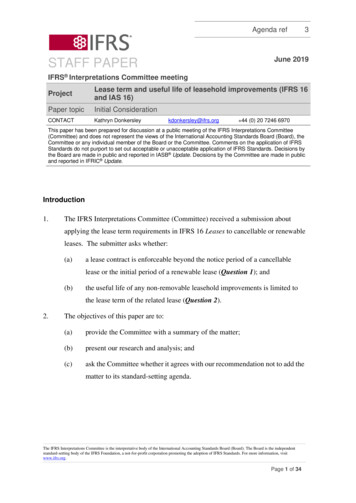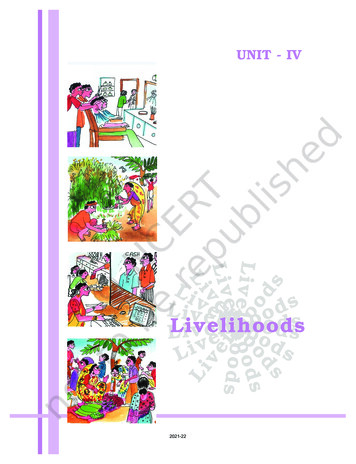
Transcription
This paper does not represent US Government views.This page is intentionally kept blank.This paper does not represent US Government views.
This paper does not represent US Government views.India: The Impact of Climate Change to 2030A Commissioned Research ReportPrepared ByJoint Global Change Research Institute andBattelle Memorial Institute, Pacific Northwest DivisionThe National Intelligence Council sponsors workshops and research with nongovernmentalexperts to gain knowledge and insight and to sharpen debate on critical issues. The viewsexpressed in this report do not reflect official US Government positions.NIC 2009-03DApril 2009This paper does not represent US Government views.
This paper does not represent US Government views.This page is intentionally kept blank.This paper does not represent US Government views.
This paper does not represent US Government views.Scope NoteFollowing the publication in 2008 of the National Intelligence Assessment on the NationalSecurity Implications of Global Climate Change to 2030, the National Intelligence Council(NIC) embarked on a research effort to explore in greater detail the national security implicationsof climate change in six countries/regions of the world: India, China, Russia, North Africa,Mexico and the Caribbean, and Southeast Asia and the Pacific Island States. For eachcountry/region we are adopting a three-phase approach. In the first phase, contracted research—such as this publication —explores the latestscientific findings on the impact of climate change in the specific region/country. In the second phase, a workshop or conference composed of experts from outside theIntelligence Community (IC) will determine if anticipated changes from the effects ofclimate change will force inter- and intra-state migrations, cause economic hardship, or resultin increased social tensions or state instability within the country/region. In the final phase, the NIC Long-Range Analysis Unit (LRAU) will lead an IC effort toidentify and summarize for the policy community the anticipated impact on US nationalsecurity.The Joint Global Change Research Institute (JGCRI) and Battelle, Pacific Northwest Division(Battelle, PNWD), developed this assessment on the climate change impact on India through2030 under a contract with SCITOR Corporation. The Central Intelligence Agency’s Office ofthe Chief Scientist, serving as the Executive Agent for the DNI, supported and funded thecontract.This assessment identifies and summarizes the latest peer-reviewed research related to the impactof climate change on India, drawing on both the literature summarized in the latestIntergovernmental Panel on Climate Change (IPCC) assessment reports and on other peerreviewed research literature and relevant reporting. It includes such impact as sea level rise,water availability, agricultural shifts, ecological disruptions and species extinctions,infrastructure at risk from extreme weather events (severity and frequency), and disease patterns.This paper addresses the extent to which regions within India are vulnerable to climate changeimpact. The targeted time frame is to 2030, although various studies referenced in this reporthave diverse time frames. The research does not draw inferences about the potential for internalor interstate conflict arising out of changes, e.g., in water supply or in likely migration fromBangladesh; such analyses will be conducted in the subsequent efforts described above.This assessment also identifies (Annex B) deficiencies in climate change data that wouldenhance the IC understanding of potential impact on India and other countries/regions.1This paper does not represent US Government views.
This paper does not represent US Government views.This page is intentionally kept blank.2This paper does not represent US Government views.
This paper does not represent US Government views.Executive SummaryIndia is both a major greenhouse gas emitter and one of the most vulnerable countries in theworld to projected climate change. The country is already experiencing changes in climateand the impacts of climate change, including water stress, heat waves and drought, severestorms and flooding, and associated negative consequences on health and livelihoods. With a1.2 billion but growing population and dependence on agriculture, India probably will beseverely impacted by continuing climate change. Global climate projections, given inherentuncertainties, indicate several changes in India’s future climate: Global observations of melting glaciers suggest that climate change is well under way inthe region, with glaciers receding at an average rate of 10–15 meters per year. If the rateincreases, flooding is likely in river valleys fed by these glaciers, followed by diminishedflows, resulting in water scarcity for drinking and irrigation. All models show a trend of general warming in mean annual temperature as well asdecreased range of diurnal temperature and enhanced precipitation over the Indiansubcontinent. A warming of 0.5oC is likely over all India by the year 2030 (approximatelyequal to the warming over the 20th century) and a warming of 2-4oC by the end of thiscentury, with the maximum increase over northern India. Increased warming is likely tolead to higher levels of tropospheric ozone pollution and other air pollution in the majorcities. Increased precipitation including monsoonal rains is likely to come in the form offewer rainy days but more days of extreme rainfall events, with increasing amounts of rainin each event, leading to significant flooding. Drizzle-type precipitation that replenishessoil moisture is likely to decrease. Most global models suggest that the Indian summermonsoons will intensify. The timing may also shift, causing a drying during the late summergrowing season. Climate models also predict an earlier snowmelt, which could have asignificant adverse effect on agricultural production. Growing emissions of aerosols fromenergy production and other sources may suppress rainfall, leading to drier conditions withmore dust and smoke from the burning of drier vegetation, affecting both regional and globalhydrological cycles and agricultural production.Uncertainties about monsoonal changes will affect farmers’ choices about which crops to plantand the timing of planting, reducing productivities. In addition, earlier seasonal snowmelt anddepleting glaciers will reduce river flow needed for irrigation. The large segment of poor people(including smallholder farmers and landless agricultural workers) may be hardest hit,requiring government relief programs on a massive scale. Finally, migration, especially fromBangladesh, may strain resources and India-Bangladesh relations.The most important impacts of climate change will likely include the following: Agriculture. High-input, high-output agriculture will be negatively affected even asdemands for food and other agricultural products rise because of an increasing populationand expectations for an improved standard of living. Millions of subsistence and smallholder3This paper does not represent US Government views.
This paper does not represent US Government views.farmers will experience hardship and hunger through being less able to predict climateconditions.1 To a certain extent, trade may compensate for these deficits. Water: Glacier melt may yield more runoff in the short term but less in the medium and longterms. More severe storms (especially cyclones) will cause more damage to infrastructureand livelihoods and exacerbate salt water intrusion in storm surges. Changes in the timingand amount of monsoon rains will make the production of food and other agriculturalproducts more uncertain, so that, even in good-weather years, farmers will be more likely tomake decisions leading to lower-productivity. Exacerbation of Inequality: The welfare of those who are affected by climate change andwho have limited means to adapt may act as a force that can change governments, strainpublic budgets, and foster unrest. About one-third of Indians are extremely poor, and 60percent depend upon agriculture for their livelihoods. Energy: As India searches for additional sources of energy to meet rising demand, climatechange mitigation efforts may constrain its use of indigenous and imported coal, oil, and gas,while development of nuclear energy will be slow at best and likely to encounter opposition.Other non-emitting technologies will require technology transfer and capacity-building. Migration: India receives immigrants from a number of countries. Under climate changeconditions, it may be flooded with many more, particularly from Bangladesh. Suchmigration may exacerbate tension between the two countries as well as putting a strain onIndian central and state governments.Adaptive capacity in India varies by state, geographical region, and socioeconomic status.Studies point to influential factors such as water availability, food security, human and socialcapital, and the ability of government (state and national levels) to buffer its people during toughtimes. Where adaptive capacity is low, the potential is greater for impacts to result in displacedpeople; deaths and damage from heat, floods, and storms; and conflicts over natural resourcesand assets.1The current accuracy of even current forecasts is in doubt. For example, the Indian Medium Range WeatherForecasting Center is not allowed to issue such forecasts in public media–that is the responsibility of the IndianMeteorological Department.4This paper does not represent US Government views.
This paper does not represent US Government views.ContentsPage1Scope NoteExecutive Summary3Introduction and Background7Projected Regional Climate ChangeClimate ObservationsClimate Predictions (Modeling)Projections of Future Temperature and PrecipitationSeasonal Weather Patterns (Monsoons)Sea Level ChangesAgricultural Growing PeriodsClimatic EventsImpacts of Climate Change on Natural EcosystemsObserved ChangesProjected Changes: The Example of ForestsImpacts of Climate Change on Human SystemsEnergy SystemEconomic Growth and DevelopmentFood Production and Drinking Water SupplyHuman HealthCoping Capabilities in Facing Natural DisastersClimate Change in NeighborhoodsAdaptive CapacityStrengths/Weaknesses in Adaptive Capacity AssessmentsConclusions: High-Risk ImpactsAgricultureWaterEnergyExacerbation of 26262730323232323232AnnexesA: Accuracy of Regional Models33B: Knowledge Gaps That Preclude a Full Evaluation of Climate ChangeImpacts Affecting India and India's Adaptive Capacities37C: State/District Vulnerability and Adaptive Capacity in India395This paper does not represent US Government views.
This paper does not represent US Government views.This page is intentionally kept blank.6This paper does not represent US Government views.
This paper does not represent US Government views.Introduction and BackgroundGlobal climate projections, given inherent uncertainties, indicate several changes in India’sfuture climate: Global observations of melting glaciers suggest that climate change is well under way in theregion, with glaciers receding at an average rate of 10–15 meters per year.i If the rate of glacial melt increases, flooding is likely in the river valleys fed by theseglaciers, followed by a diminished flow, resulting in a scarcity of water for drinking andagricultural irrigation. All models show a trend of general warming in mean annual temperature as well asdecreased range of diurnal temperature and enhanced precipitation over the Indiansubcontinent.ii A warming of 0.5oC is likely over all India by the year 2030 (approximately equal to thewarming over the 20th century) and a warming of 2-4oC by the end of this century, with themaximum increase over northern India.iii Increased precipitation is likely to come in the form of fewer rainy days but more days ofextreme rainfall events, with increasing amounts of rain in each event, leading to significantflooding.iv Fine precipitation (drizzle-type) that replenishes soil moisture is likely todecrease. Increased warming is likely to lead to higher levels of tropospheric ozone pollution and otherair pollution in India’s major cities.v Most global models suggest that the Indian summer monsoons will intensify with a warmingclimate. The timing may also shift, causing a drying during the late summer growingseason.vi Climate models also predict an earlier snowmelt, which could have significant adverseeffects on agricultural production, both irrigated and non-irrigated.vii Growing emissions of aerosols from energy production and other sources may suppressrainfall, leading to drier conditions with more dust and smoke from the burning of driervegetation, affecting both regional and global hydrological cycles and agriculturalproduction.viiiIn both its greenhouse gas emissions and its vulnerability to climate change, India is one of themost significant countries in the world. With a large and growing population, India’s emissionsof greenhouse gases are increasing. Moreover, potential climate impacts in India are severe: sealevel rise, changes in the monsoon, increased severe storms and flooding, more drought, andsevere water stress. Recently, climate variability in the form of floods and cyclones has resultedin destruction of crops, property and infrastructure, as well as in negative impacts on humanhealth and well-being. All of these impacts set back general socio-economic development.Rural dwellers’ continuing dependence upon agriculture for food and livelihood (17.5 percent ofgross domestic product (GDP) and more than 60 percent of the labor force)ix makes the Indianpeople particularly vulnerable to climate variability and change. Nowhere is this more evident7This paper does not represent US Government views.
This paper does not represent US Government views.than in the linkage of the annual monsoon cycle and agricultural production, commonly referredto as, “Indian agriculture gambles with monsoon.”The diversity and extremes of India’s climate and geography are characteristic of its society aswell. Religious and cultural diversity is a major feature of Indian life. The strong Hindutraditions have been synthesized with and challenged by other religions, notably Islam,Christianity, and Sikhism. India has at least 300 known languages, 24 of which have at least onemillion speakers each. There are differences, sometimes amounting to estrangement, betweenthe North, with its history of grand-scale invasions, and the relatively stable South. Religiousdivisions became geographical divides when Muslim Pakistan (1947), then Bangladesh (1971),were created, and ethnic and caste-related strife continues among groups. However, theconnectedness of the extended family is a core feature of Indian life. Together with a sense ofcivil society’s claims on individuals and families, the extended family knits the society togetherand emphasizes interdependence.xDiversity and extremes are evident in India’s patterns of economic development as well. In thissphere, two themes stand in contrast: modernist, democratic, and technical development,intensified by the economic liberalization beginning in the early 1990s; and persistent poverty,subsistence agriculture, and caste-based discrimination. Various models of development havebeen advanced. Dasxi characterizes the country-level model thus: “Rather than adopting theclassic Asian strategy—exporting labor-intensive, low-priced manufactured goods to the West—India has relied on its domestic market more than exports, consumption more than investment,services more than industry, and high-tech more than low-skilled manufacturing.” Kerala’smodel of human development emphasizes education, health services, and equality; however,slow economic development has somewhat tarnished this model, as incomes remain low and thecontributions of Keralans working abroad continue to be very much needed.xii The Karnatakamodel focuses on technology, centered in Bangalore, and historically participatory localgovernance by Panchayat. Yet Karnataka also has “enduring gender inequity and regionaldisparities, and a visibly increasing gap between urban and rural areas.”xiiiDespite substantial economic and general development progress, poverty, malnutrition, illiteracy,and inequalityxiv continue to plague India, as well as serious environmental issues. India has notonly several Silicon Valleys but also several Nigerias.xv In addition, the ongoing dispute withPakistan over Kashmir and ethnic strife (e.g., in Assam) claim national attention. Conflict withPakistan has lessened by confidence-building measures since 2002, when nuclear war was hintedat, but such hints arose again after the recent terrorist attack in Mumbai, although the response sofar has been relatively temperate.India’s broad spectrum of highly articulated national policies includes inclusive growth goals inthe areas of economic development, human development, and environmental protection.National goals are, of course, differentially implemented in each of India’s states, which exhibitwidely varying degrees of social and economic development. Limited growth has occurred inthe areas of fiscal policy, privatization, small-scale industry, agriculture, and labor law.xviAt the national level, India’s climate change policies are subsumed in its economic-industrial andhuman development policies, which come first. Local policies have had some success in limitingsignificant urban air pollution problems. Substantial improvements in local air quality in Delhi,for example, have resulted from recent government programs to improve the quality of petroland diesel fuels, introduction of emissions standards for vehicles, and conversion of buses and8This paper does not represent US Government views.
This paper does not represent US Government views.three-wheelers to compressed natural gas (CNG) fuel—but Kolkata and other metropolitancenters experience worsening air quality, with increasing combustion of fossil fuels contributingto carbon dioxide emissions. Generally speaking, climate change policy has been reactive ratherthan proactive and focused largely on the energy sector. According to reports from theOrganization for Economic Cooperation and Development (OECD) and the Pew Center,xvii India,through normal policy developments, is “making significant progress in limiting greenhouseemissions” (i.e., from what emissions might have been) through energy efficiency improvementsand environmentally friendly energy development. Also, India is participating in the CleanDevelopment Mechanism of the United Nations Framework Convention on Climate Change(UNFCCC) and actively participating in the development of a proposed UNFCCC mechanismcalled Reducing Emissions from Deforestation and forest Degradation (REDD). The NationalClean Development Mechanism Authority (NCDMA) is housed in the Ministry of Environmentand Forests (MoEF); CDM India has operated since December 2003 as the Designated NationalAuthority (DNA). More aggressive measures, India feels, should be financed by developednations as they lead by reducing their own emissions and engaging in clean technology transfer,in accordance with the 1992 UNFCCC (ratified by 192 countries).Internationally, India has played a key role in climate negotiations at several points. India brokethe impasse at the first Conference of the Parties by leading the development of a commonstatement that became the basis for the Berlin Mandate. More recently, India hosted the eighthConference of the Parties to the Framework Convention on Climate Change in 2002. India,bolstered by nongovernmental organizations such as the Tata Energy Research Institute (TERI)and the Centre for Science and Environment (CSE), focuses on per capita emissions (low inIndia and high in most developed countries) and on cumulative emissions (also low indeveloping countries and high in developed countries), as the indicators that developed countriesshould undertake mitigation first. Government officials press developed nations to establish andconform to emissions reduction goals and to engage in technology transfer to developingcountries.CSE rebutted the second World Resources Report,xviii making the distinction between“subsistence emissions” of the poor (mostly in developing countries) and the “luxury emissions”of the rich (mostly in developed countries). CSE has also characterized “green” policies dictatedby the North (e.g., debt-for-nature swaps) as unwarranted interference in other nations, asexacerbating inequality among nations, and as likely to foster unsustainable management.Projected Regional Climate ChangeThe current climate of India is highly diverse, ranging from the subfreezing Himalayan wintersto the tropical climate of the south. The states of Assam and West Bengal experience extremelydamp, rainy, and humid conditions, while the regions of Rajasthan and Gujarat make up part ofthe arid Great Indian Desert. Based on precipitation and temperature, India can be divided intosix climatic regions: the Himalayas, Assam and West Bengal, the Indo-Gangetic Plain, theWestern Ghats and coast, the Deccan (the interior of the Peninsula south of the Narmada River),and the Eastern Ghats and coast.xixThe Indian Meteorological Service divides the year into four seasons, two of which arecharacterized by monsoon conditions. Winter occurs from December through February, whenconditions are generally relatively dry and cool. March through May is considered to be9This paper does not represent US Government views.
This paper does not represent US Government views.summer, as the conditions are usually hot and dry. During this period temperatures throughoutnon-Himalayan India reach the upper 30s C and can reach as high as 48 C during the day in thepre-monsoon months.The southwest monsoon season occurs from June through September, when the predominatingsouthwest maritime winds bring rains to most of the country. One branch of the southwestmonsoon, known as the Arabian Sea monsoon, generally breaks on the west coast early in theseason and spreads across South Asia by early July. The other, known as the Bay of Bengalmonsoon, spreads over Assam during June and travels along the Indo-Gangetic Plain towardNew Delhi, merging with the Arabian branch to bring rains farther north. The southwestmonsoon provides almost 80 percent of the annual rainfall to most of the country. It is criticallyimportant to agricultural production; predictions of its timing are used by agronomists andfarmers to determine optimal dates for plantings.The northeast monsoon occurs in October and November as the southwest monsoon retreats.The states of Tamil Nadu, Karnataka, and Kerala receive most of their rainfall from the northeastmonsoon during November and December. (See Figure 1 for a map of Indian states andhttp://en.wikipedia.org/wiki/File:India climatic zone map en.svg for climate regions.)Interannual climate variability is linked to a global-scale, naturally occurring phenomenonknown as the El Niño/Southern Oscillation (ENSO) cycle.2 ENSO can explain some of the interannual rainfall variability over the subcontinent of India and can affect the location and activityof tropical storms. Analysis of observational data shows a significant correlation between ENSOand tropical circulation and precipitation such that there is a tendency for less Indian summermonsoon rainfall in El Niño years and above-normal rainfall in La Niña years. However, theeffect is not linear. The ability to accurately predict the timing and occurrence of the ENSOphenomenon is extremely important to agricultural production.2The terms El Niño and La Niña represent opposite extremes of the ENSO cycle. El Niño refers to the aboveaverage sea-surface temperatures that periodically develop across the east-central equatorial Pacific. It representsthe warm phase of the ENSO cycle and is sometimes referred to as a Pacific warm episode. La Niña refers to theperiodic cooling of sea-surface temperatures across the east-central equatorial Pacific. It represents the cold phaseof the ENSO cycle, and is sometimes referred to as a Pacific cold episode.10This paper does not represent US Government views.
This paper does not represent US Government views.Figure 1. Indian States.Climate ObservationsGlobal observations suggest that climate change is well under way. At continental, regional, andocean basin scales, numerous long-term changes in climate have been observed, includingwidespread changes in precipitation amounts; ocean salinity; wind patterns; and aspects ofextreme weather including droughts, heavy precipitation, heat waves, and the intensity oftropical cyclones. Studies of the tropical Indo-Pacific region show unusual warmth in the 20thcentury, and many isotope records show a trend toward warmer conditions in the tropical IndianOcean. In most multi-centennial coral series, the late 20th century is shown to be warmer thanany time in the past 100 to 300 years.Some studies have suggested that the South Asian (Indian) monsoon, in the drier areas of itsinfluence (northwest India), has recently reversed its millennia-long orbitally driven, lowfrequency trend toward less rainfall. This recent reversal in monsoon rainfall also appears tocoincide with a synchronous increase in inferred monsoon winds over the western Arabian Sea, achange that could be related to increased summer heating over and around the Tibetan Plateau.Globally, estimates of the potential destructiveness of tropical storms and hurricanes show asubstantial upward trend since the mid-1970s, with a trend toward longer storm duration andgreater storm intensity. Storm activity is generally correlated with tropical sea surfacetemperature.The distributions of global minimum and maximum temperatures have shifted to higher values,consistent with overall warming.xx More warm extremes imply an increased frequency of heatwaves. However, cold extremes have warmed more than the warm extremes over the past 5011This paper does not represent US Government views.
This paper does not represent US Government views.years. Further indications include the observed trend toward fewer frost days associated with theaverage warming in most mid-latitude regions. A prominent indication of a change in extremesis the evidence of increases in heavy precipitation events over the mid-latitudes in the past 50years, even in places where mean precipitation amounts are not increasing. For very heavyprecipitation events, increases are reported as well, but results are available for only a few areas.Recent warming in sea surface temperatures (SSTs) is strongly evident at all latitudes, althoughthere are inter-hemispheric differences. Much of the surface of the Indian Ocean has warmedsince 1955, with the major exception of the 5 S to 20 S latitude belt. The Southern Ocean (southof 35 S) in the Atlantic, Indian, and Pacific sectors has generally warmed. The regions thatexhibit cooling are mainly in the shallow equatorial areas and in some high-latitude regions. Inthe Indian Ocean, cooling occurs at subsurface depths centered on 12 S (South EquatorialCurrent) at 150 m depth and in the Pacific centered on the equator and 150 m depth. In thetropical and eastern subtropical Indian Ocean (north of 10 S), warming in the upper 100 m isconsistent with the significant warming of the sea surface from 1900 to 1999. The surfacewarming trend during the 1900 to 1970 period was relatively weak but increased significantly inthe 1970 to 1999 period, with some regions exceeding 0.2 C per decade. Models suggest thatupper-ocean warming in the South Indian Ocean can be attributed to a reduction in the strengthof the southeast trade winds and associated decrease in the southward transport of heat from thetropics to the subtropics.Local and regional changes in the character of precipitation also depend a great deal onatmospheric circulation patterns determined by El Niño, the North Atlantic Oscillation (NAO),xxiand other patterns of variability. India’s rainfall features show strong variability but little in theway of a century-scale trend, even as the linear trends of rainfall decreases for 1900 to 2005 were7.5 percent in western Africa and a similar decrease was observed when averaged over thebroader southern Asia region as a whole. Over much of northwestern India, the 1901 to 2005period shows precipitation increases of more than 20 percent per century, but the same areashows a strong decrease in annual precipitation in the 1979 to 2005 period.Very dry land areas across the globe have more than doubled in area since the 1970s, anobservation that has been associated with precipitation decreases related to ENSO and withsubsequent increases primarily due to surface warming. The tendency of the warming to bemore pronounced in winter is a conspicuous feature of the observed temperature trends overIndia, one that is likely to continue.Climate Predictions (Modeling)While Global Circulation (or Climate) Models (GCMs) can be used to infer climate changes inspecific regions, it is far preferable to develop models that have a high resolution sufficient toresolve local and regional scale changes. There are many challenges in reliably simulating andattributing observed temperature changes at regional and local scales. At these scales, naturalclimate variability can be relatively greater, making it harder to distinguish long-term changesexpected due to external radiative forcings.33Radiative forcings are changes in the net irradiance at the tropopause resulting from a change in an external driverof climate change, such as carbon dioxide or the output of the Sun. These changes in net irradiance are expressed aswatts per meter squared (Wm2).12This paper does not represent US Government views.
This paper does not represent US Government vi
change mitigation efforts may constrain its use of indigenous and imported coal, oil, and gas, while development of nuclear energy will be slow at best and likely to encounter opposition. Other non-emitting technologie










